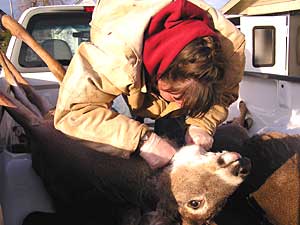|
Audio
Photos
More from MPR
Resources
Your Voice
|
DNR continues CWD tests on deer
November 9, 2004
Tens of thousands of deer hunters hit the woods this past weekend for the opener of Minnesota's firearms deer season. Many of those hunters provided tissue samples from their deer, which will be tested for chronic wasting disease. The testing marks the third and final year of a statewide survey. So far, the fatal brain disease hasn't been found in Minnesota's wild deer herd. DNR officials say this year, the testing has become much simpler.
Kelliher, Minn. — Up until this year, the DNR had to cut off the head of every deer tested for chronic wasting disease. Now, all they need are two lymph nodes located on either side of the animal's esophagus. At a DNR sample collection site in Kelliher, about 50 miles north of Bemidji, the whole process takes only a few minutes.
 | |||
Cassie Lessman is hunched over the carcass of a nice-sized buck in the back of a trailer. Lessman is in the animal science program at the University of Minnesota. About 60 U of M students are helping with the DNR's chronic wasting disease test program.
"I'm going to cut a slit in its neck, and then I'm going to be looking for the two lymph nodes, which are kind of deep in the throat," said Lessman. Sometimes they're kind of hard to find... that's a lymph node right there."
Lessman pulls out a small wad of red, meaty flesh about the size of a kidney bean. She slips it into a plastic bag. The sample will be sent to a University of Minnesota veterinary lab for testing.
Paul Johnson of Mounds View says his daughter shot the deer earlier that day just south of Baudette. Johnson didn't mind submitting the animal for testing.
 | |||
"It's not bothering any of the meat, it's not disturbing anything," said Johnson. "It's not as invasive as like pulling the skull or anything like that, no big deal. And if this is a good way to catch CWD, then I'm all for it."
Johnson says he wasn't too worried about chronic wasting disease this year. That seems to be a trend among hunters. DNR officials say when the agency began testing for chronic wasting disease in 2002, it got lots of media attention. They say there was mild hysteria, and some hunters chose to stay home. Steve Caron, a DNR wildlife manager in northern Minnesota, says people are much better educated about the disease.
"People realize that we haven't found it, and if we do have it in our wild deer, it's not a human health risk whatsoever," said Caron. "There's no documented cases of people getting the human variant of mad cow disease from chronic wasting disease. And if it does show up, you know, there are states out west like Wyoming and Colorado that it's been there for 25, 30 years. And they just manage around it."
 | |||
DNR officials say there are no plans to do any more broad, random sampling in Minnesota after this year. Lou Cornicelli, the DNR's big game coordinator, says that kind of testing is expensive. Cornicelli says the agency will now take a step back and test only when necessary. That's a common strategy in states where chronic wasting disease hasn't been found in wild deer.
"Presumably, if all of our samples are negative, what we'll do is we'll continue to test animals that are exhibiting symptoms of the disease," Cornicelli said. "And also, if we were to get a positive in a game farm or some other situation, we'd look at that area and address it, whether it's through additional sampling, some herd reductions or whatnot."
About 500 people helped with the test effort this past weekend. That included 225 DNR staff, students from seven colleges and universities, and volunteers from other groups and agencies. The goal is to collect a total of 11,000 lymph node samples. Officials say they'll probably finish up by the end of next weekend.
|
News Headlines
|
Related Subjects
|

